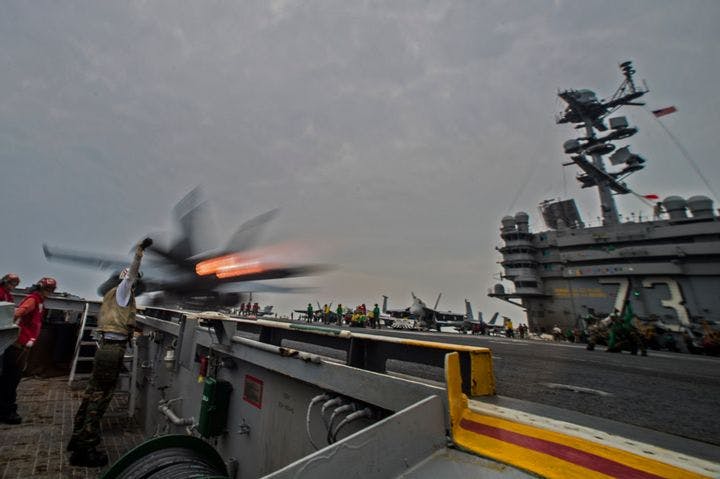Fall 2011
When did the South China Sea become valuable? 1995.
– The Wilson Quarterly
For much of history, the South China Sea was an “obscure afterthought.” That changed in 1995.
The South China Sea is one of the most valuable pieces of marine real estate in the world. A third of global maritime traffic passes through its sea-lanes, and its depths contain significant stores of oil and natural gas. Six of the nine countries with coastline bordering its 1.35 million square nautical miles (China and Taiwan, as well as Malaysia, Brunei, Vietnam, the Philippines, and Indonesia) have lodged competing claims to the sea or its manifold atolls, reefs, and small islands. The stage is set for struggle.
For much of history, the South China Sea was an “obscure afterthought,” writes Marvin C. Ott, a public policy scholar at the Woodrow Wilson Center. That changed in 1995, when Filipino officials learned that China had built an outpost on the aptly named Mischief Reef, 120 nautical miles from Filipino territory but 600 from the closest Chinese island chain. The startling discovery came even as China was launching a wave of diplomatic efforts to demonstrate to the world that it was undertaking a “peaceful rise.” In 2002, China signed a declaration with the Association of Southeast Asian Nations (ASEAN) pledging that all parties would act in good faith until competing claims to the sea were resolved.
Tension eased, but then Chinese patrol craft began seizing Vietnamese fishing boats and harassing U.S. naval surveillance ships operating in the contested waters. China also continued to develop its military capacities on Mischief Reef. Last year, to the relief of many ASEAN countries, U.S. secretary of state Hillary Clinton pointedly criticized Beijing’s policy, stating that the United States favored “freedom of navigation, open access to Asia’s maritime commons, and respect for international law.” A Chinese Ministry of Defense spokesman retorted that “China has indisputable sovereignty” over the sea. As if to underscore the point, a Chinese submarine descended to the sea’s deepest part and planted a Chinese flag in the seabed.
China’s actions are “beyond serious,” Ott contends. China is in violation of the U.N. Convention on the Law of the Seas, which holds that nation-states cannot assert sovereignty over international waters. The conflict has the “clear potential to spark armed conflict between the United States and China,” he adds.
There’s no saying where China’s territorial ambitions will stop, warns Dana Dillon, author of The China Challenge (2007). In his view, China’s foreign policy is centered on a “Chinese world order... where China is the central power and Beijing is the global political pole.” Dillon thinks the conflict’s resolution rests in the hands of ASEAN. “Ironclad security treaties and the presence of American warships are not enough to protect Southeast Asian countries if they are not willing to defend themselves,” he writes.
Robert D. Kaplan, a senior fellow at the Center for a New American Security and a member of the U.S. Defense Department’s Defense Policy Board, is more sanguine. He foresees a “naval century” for the region, in which cool assessments of interest prevail over ideology and crucial decisions are largely the domain of non-ideological defense experts. Kaplan believes that the United States should maintain its presence in the South China Sea while also accommodating China’s inevitable naval expansion, seeking “balance not dominance.” China may well be content to extend its power without meddling in the affairs of the ASEAN countries, leaving them free to enjoy the security the United States offers as well as the fruits of China’s investment dollars.
THE SOURCES: “Countering Beijing in the South China Sea” by Dana Dillon, in Policy Review, June–July 2011; “The South China Sea Is the Future of Conflict” by Robert D. Kaplan, in Foreign Policy, Sept.–Oct. 2011; “Deep Danger: Competing Claims in the South China Sea” by Marvin C. Ott, in Current History, Sept. 2011.
Photo courtesy of The U.S. Navy
